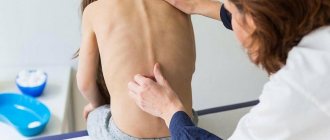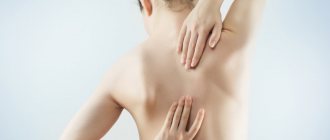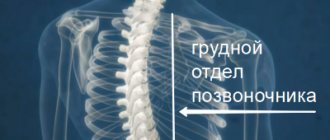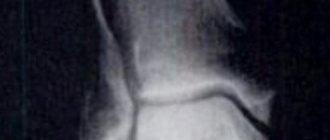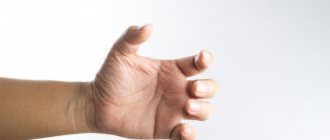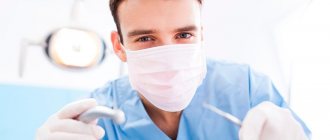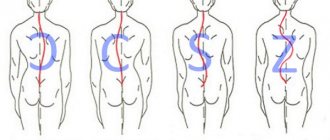16 September 2020
40917
0
4.1 out of 5
S-shaped scoliosis is the second most severe type of spinal curvature in the direct projection. It is characterized by the formation of two differently directed bending arcs, one of which is the main one, and the second is compensatory, i.e., formed in response to the formation of the first. Thus, S-shaped scoliosis differs from C-shaped scoliosis, in which the main curve is located in the thoracic spine. In an effort to restore stability and the vertical axis of the body, compensatory mechanisms are activated, resulting in the formation of a second arch with a bend in the opposite direction.
The pathology develops slowly, without pronounced symptoms, so it is most often discovered during a preventive medical examination. At the same time, S-shaped scoliosis can cause significant harm to the body and cause displacement of internal organs, which will be accompanied by severe pain and the inability to remain in an upright position for a long time. Therefore, the disease must be detected as early as possible and measures taken immediately to eliminate it.
Most often, S-shaped scoliosis is found in children and adolescents 8-16 years old and in older people who already had minor spinal deformities.
Spinal scoliosis in adults: symptoms
The leading manifestation of lateral curvature is back pain, the intensity of which depends on its degree. The early stages of deformation do not cause pain, and the destructive process can be recognized only by external signs. Even with minor scoliotic changes, the symmetry of the shoulders and shoulder blades is disrupted, and the pelvic crests also shift relative to the horizontal axis. One shoulder blade sticks out on the side in which the spine has deviated.
The stage of deformation is determined by the angle of the scoliotic curve and includes 4 degrees:
- 1st degree, ∠10° and less. A slight stoop, the head is slightly lowered forward, there is asymmetry in the waist and shoulders;
- 2nd degree, ∠11–25°. There is a persistent curvature of the spine, which is noticeable in any position. The pelvis on the side of the top of the arch drops, the shoulder girdles are asymmetrical, a bulge appears on the back on one side and a depression on the other. A roll of spasmed muscles is felt in the lumbar region;
- 3rd degree, ∠26–50°. The ribs begin to protrude, especially in the front, and the intercostal hump is noticeable when tilted. The abdominal muscles weaken, muscle contractures form, reducing range of motion;
- 4th degree, ∠50° or more. Severe deformation with the presence of all the signs described above. The muscles in the curvature zone are greatly stretched, there is an intercostal hump, and the ribs are sunken on the sunken side of the back.
For reference! Most often, the scoliotic curve is localized in the thoracic and lumbar regions.
Treatment
Conservative treatment of scoliosis GOP
The choice of treatment methods depends on the severity of thoracic scoliosis. Treatment should be comprehensive, it involves physiotherapists, massage therapists, exercise therapy instructors, vertebrologists, and chiropractors.
Non-progressive disease of grade 1–2 should be treated using conservative methods. It is important to eliminate the causes of curvature of the thoracic spine, reduce the static load on it, and maintain moderate physical activity. The patient must perform special exercises, attend massage sessions, and swimming to stop the development of the pathology. It is also very important to follow an orthopedic regimen: sleep on a backboard, monitor your posture, periodically take a horizontal position so that the spine rests.
The massage technique for scoliosis is selected separately for each patient. The purpose of the sessions is to strengthen the back muscles, increase the tone of the abdominal muscles, reduce or eliminate deformation of the spinal column, stop the development of pathology, and improve the trophism (nutrition) of tissues.
If scoliosis of stages 1–2 develops rapidly, then treatment is supplemented with an individual complex of therapeutic exercises, physiotherapeutic procedures, orthopedic massage, and gentle manual therapy techniques. The patient must wear special orthopedic corsets that help correct minor deformities.
For scoliosis, therapeutic exercises are indicated
Therapeutic exercise allows you to strengthen muscles, reduce the load on the vertebrae, and improve blood circulation in the damaged area. An instructor prepares a special set of exercises for the patient. First, classes are conducted under the supervision of a methodologist, and then you can move on to home training. You can supplement therapeutic exercises with yoga or swimming.
Treatment of scoliosis GOP is complemented by physiotherapeutic procedures:
- electromyostimulation;
- magnetic therapy;
- amplipulse therapy;
- hydrotherapy;
- mud treatment;
- heat therapy;
- electrophoresis with painkillers, etc.
Physiotherapy for scoliosis helps restore metabolic processes, increases blood supply, and reduces pain and inflammation in the affected area.
Surgical assistance
If at stage 3 of thoracic scoliosis complex conservative treatment can still help, then at stage 4 it is impossible to do without surgery.
Surgical therapy is used for severe deformation of the thoracic spine, which cannot be treated with conservative methods for a long time. In addition, surgery is prescribed if scoliosis exceeds 40°, the functionality of vital internal organs is impaired, as well as for chronic untreated scoliosis.
Reference. The optimal period for performing surgery on a child is from 10 to 14 years.
The purpose of the operation is to correct the existing curvature of the spine, as well as fix the vertebrae with special metal structures. For this purpose, a distractor (a device in the form of a double-sided two-horned fork) by Harrington, Kazmin, a Rodnyansky-Gupalov endocorretor, etc. is used. Before the operation, traction (stretching) of the spine is performed.
If indicated, the doctor may prescribe the following operations:
- Wedge-shaped resection of vertebral bodies and processes on the convex side of the deformity.
- Tenoligamentocapsulotomy according to L.I. Shulutko - mobilization of the spinal column along the concave side with dissection of tendons, ligaments, and joint capsules. This operation is the first stage of spinal column correction.
- Discectomy is the removal of abnormal disc material that is compressing the spinal cord or its root.
- Resection of the scoliosis hump.
- Marginal resection of the scapula, etc.
After the operation, long-term rehabilitation is carried out.
However, severe GOP scoliosis cannot be corrected even with surgery. However, timely surgical procedure will help stop further deformation of the spine, as well as avoid complications that can be life-threatening.
Kinds
Scoliosis is classified according to the presence of structural changes in the spine, the causes of its occurrence, as well as the location and rate of progression. According to the first classification, curvature can be structural or non-structural. The latter is easier to cure, since there is every chance of eliminating the root cause.
Types of non-structural scoliosis:
- postural, caused by poor posture. If you take an X-ray in the supine position, you will not be able to diagnose scoliosis due to the absence of structural deformation. The curvature is not visible even when a person bends forward;
- reflex, which appears as a result of a long stay in a forced position due to a pain symptom;
- compensatory, when the misalignment of the back equalizes – compensates – for the difference in leg length;
- hysterical, having a psycho-emotional nature and occurring in rare cases.
Types of structural scoliosis:
- congenital, caused by underdevelopment, wedge-shaped vertebrae, fusion of ribs and/or transverse processes;
- neuromuscular, occurring against the background of spinal cord injuries, myopathies, cerebral palsy, multiple sclerosis;
- dysplastic, the cause of which lies in connective tissue dysplasia. Diagnosed with Marfan and Ellers-Danlos syndromes;
- post-traumatic, provoked by fractures, surgical interventions, scar contractures. It can develop after burns, as a result of purulent complications and after operations on the chest organs;
- rare species caused by impaired bone formation, osteomyelitis, homocystinuria or tumors;
- idiopathic, when the cause cannot be determined. This type accounts for 80 to 90% of all cases of scoliosis.
The most important
As you can see, scoliosis of the thoracic spine is a serious and dangerous pathology. Its danger is that in the first two stages it is not always possible to notice the deformation. Although with grade 2 scoliosis there is a greater chance of noticing characteristic symptoms. The disease should not be ignored, as it can progress quickly, causing dangerous complications. Thoracic scoliosis can not only worsen the appearance, but also compress important internal organs (lungs, heart, etc.) and disrupt their functioning. In the worst cases, the disease can lead to disability and even death. Timely and competent comprehensive treatment will help correct minor curvature of the spine, as well as avoid complications. For this purpose, exercise therapy, massage, manual manipulation, and physiotherapy are used. In advanced cases, surgery is necessary. It is necessary to begin the prevention of thoracic scoliosis, starting from the period of intrauterine development and throughout life.
How to find out if there is a curvature of the spine
There is a special test that can detect signs of scoliosis in adolescents and children. To pass it, the child must stand up straight and lower his arms along his body. The curvature will be indicated by:
- asymmetry of the left and right sides of the body;
- different heights of shoulders and shoulder blades;
- protrusion of one of the shoulder blades more strongly than the other;
- deviation from the vertical of the cervical, thoracic and/or lumbar vertebrae;
- different levels of dimples on the upper back of the buttocks;
- difference in the height of the ears, ridges of the pelvic bones;
- skewed triangles at the waist, noticeable by the unequal distance between each arm and the waist.
All these symptoms are more pronounced when the patient is in an inclined position. But they are also characteristic of poor posture. To distinguish one from the other, you need to examine the child’s body in a lying position. If the asymmetry has not disappeared, then there is every reason to suspect scoliosis.
For reference! The next step after identifying suspicious signs should be to visit an orthopedist. He will make an accurate diagnosis based on the examination results.
Preventive measures
It is necessary to engage in the prevention of thoracic scoliosis during the period of gestation. To do this, a pregnant woman must take medications based on vitamin B12 and folic acid. These beneficial substances are necessary for the normal development of the nervous and musculoskeletal systems of the fetus.
Further prevention consists of following the following rules:
- Do not force a baby under one year old to sit down, wait until he wants it himself.
- Periodically give your child vitamin D3-based medications, but after consulting with your pediatrician.
- Make sure that your child does not spend a lot of time at the computer or book, do exercises with him.
- Teach your student to wear a backpack on both shoulders.
- Teach your child to sit correctly at a desk or desk.
- Buy an orthopedic mattress for your child; it won’t hurt adults either.
- Go swimming.
- Visit your doctor periodically for a physical examination.
If posture is impaired, children and adults are advised to undergo physical therapy, restorative massage, and swimming.
How to identify scoliosis: diagnosis
To recognize the curvature, examination and radiography are performed. To measure the angle of deviation of the spinal column, a scoliometer is used - today it is a digital device that is applied to the back and gives the value of the angular degree. The examination consists of checking reflexes, range of motion in joints, symmetry of body parts and muscle strength. For clarity, the patient is asked to bend forward and reach with his fingertips towards the floor - in this position the deformity is most noticeable. X-ray specifies the clinical picture and shows the structural features of the curvature. The photographs clearly show changes in the vertebrae and their position relative to their axes. X-ray examination allows you to assess in detail the condition of deformed and unchanged vertebrae and determine the degree of scoliosis.
Causes
Previously, medicine did not have enough tools and knowledge to accurately diagnose the causes. It was believed that thoracic scoliosis occurs due to muscle weakness. In modern practice, experts identify many more provoking factors. Despite this, 80% of the causes of thoracic scoliosis cannot be determined.
The development of the disease often occurs when sitting incorrectly, incorrect posture, when there is a load on the shoulders, at different levels, on the back. The problem is typical for patients with sedentary work. People at risk include people with the following problems:
- Congenital pathologies and anomalies in muscles and ligaments.
- Leg injuries in which one becomes shorter.
- Rickets.
- Congenital muscle atrophy.
- Tumors.
- Cerebral palsy.
With kyphoscoliotic deformity of the thoracic spine, osteochondrosis and inflammation of the muscle tissue of the back are added to the described causes.
The baby may have a slight curvature, but most often it is insignificant. The development of a strong angle of curvature is possible as a result of loads:
- While holding the head, cervical lordosis appears.
- When trying to sit down, kyphosis of the thoracic region begins.
- During the first steps and standing on your feet, lumbar lordosis appears.
The complete formation of the spine in a person occurs by the age of 17, but changes can be seen much earlier. With constant stress, scoliosis begins to develop, especially on one side.
In an adult, pathology occurs as compensation so that the body can maintain balance. Main reasons:
- Defeat, back injury, spinal hernia.
- Injury to the chest muscles.
- Leg fractures, malunion.
- Osteoporosis.
- Osteochondrosis.
- Carrying a weight on one side of the body, for example, a school backpack on the left or right shoulder.
- Inflammatory processes in the spine.
If pain appears in an adult or child, you should immediately consult a doctor, undergo an examination and, if scoliosis is detected, begin urgent treatment.
results
| ✓ Relief of pain symptoms |
| ✓ Restoration of the functions of the musculoskeletal system |
| ✓ Formation of healthy and beautiful posture |
The reputation of the clinic is strengthening and growing every year!
The ADANAYA Clinic, specializing in the treatment of diseases of the spine and joints, has a team of specialized specialists in the treatment of scoliosis. For more than 7 years, we have been successfully restoring the health of our patients, restoring them the freedom and joy of movement without pain. Treatment at the clinic gives positive results in 98% of cases, which is confirmed by reviews of our specialists.
We do not leave you alone with the disease. We heal with our hands and heart.
Why is it dangerous?
The danger of thoracic scoliosis is the disruption of the functioning of organs, the spine and the entire skeleton. Among the main complications and dangers are:
- Herniated discs between vertebrae.
- Malfunctions of the pelvic and knee joints, resulting in restrictions on movement and pain in the limbs.
- Abdominal pressure increases.
- The functioning of the respiratory organs is disrupted, drainage worsens, leading to pneumonia and bronchitis.
- The heart cannot function normally, and organ failure occurs.
- Possible kidney stone disease.
- Gastrointestinal diseases.
In addition to the described factors, which greatly worsen a person’s quality of life, patients have a disturbed psychological background, possibly a severe depressive state, neuroses.
Physiotherapy methods
In the early stages of the disease, physiotherapy is used to relieve inflammation, improve blood flow and normalize metabolic processes. After completing the course, pain and other signs of pathology disappear. Different types of treatment are used for treatment:
- UHF.
- Magnetotherapy.
- Mud treatment.
- Electrophoresis.
- Baths.
- Ultrasound.
- Laser therapy.
The choice of method, course of treatment and frequency of visits to procedures is determined by the attending doctor after diagnosing the patient. Such methods are not the main ones, but are used in addition to other treatments.
Radical therapy
Stages 1-2 of the disease do not require surgical intervention; for stages 3-4, surgical treatment is one of the prerequisites. Radical treatment is effective for children; the effectiveness is lower in adults.
Any type of operation is characterized by the installation of plates, hooks and other structures made of titanium. For children, movable devices are used so that they grow with the skeleton; for adults, fixed devices are used. The main task is to fix the spine in an even position. After such treatment there will be a recovery period, rehabilitation is 3-6 months. You must wear a corset.
Prevention
Thoracic scoliosis appears from birth, or can be acquired. In order to exclude congenital pathology, during pregnancy a woman should drink vitamin complexes and also take folic acid. To prevent scoliosis in the future it is necessary:
- Teach a child to sit no earlier than he should.
- School-age children should choose the right backpacks for school, wear them on two shoulders, and buy high-quality shoes.
- Exercise, exercise.
- Watch your posture and sit correctly at the table.
- Maintain a balanced diet.
- Consume B vitamins, as well as D3.
Using preventative tips, scoliosis will not appear even with age. Ideal for preventing illness are activities in the pool, playing volleyball.
Patients who want to self-treat should remember that incorrect methods of therapy can only accelerate the progression of pathology and deterioration of the condition. You can often hear methods of treatment using gymnastics by Strelnikova and other people. In general, the methods are good and are beneficial during treatment, but only with an integrated approach, combining exercises with other types of treatment.
(
1 ratings, average: 5.00 out of 5)
